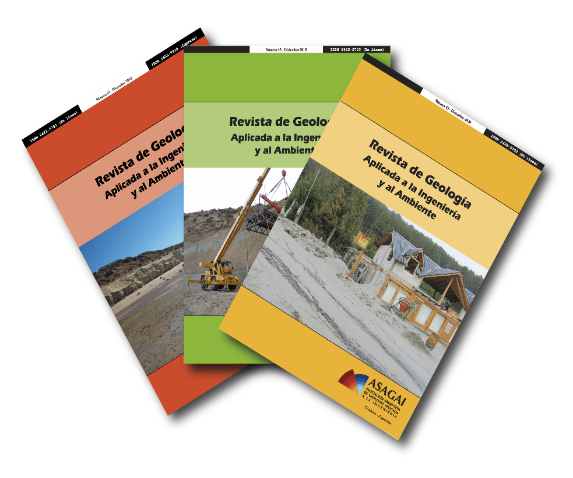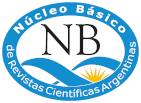Structural stability assessment of the Arenal Cavern, Cuchillo Curá protected natural area, Neuquén
DOI:
https://doi.org/10.59069/24225703ee010Keywords:
cave susceptibility, expansive clays, GCI, Q IndexAbstract
The ANPCC (Cuchillo Curá protected natural area) currently contains the most extensive cave system in Argentina, with more than 5 kilometers extension represented by Arenal, The ANPCC (Cuchillo Curá protected natural area) currently contains the most extensive cave system in Argentina, with more than 5 kilometers extension represented by Arenal, Templo, Gendarme and Cabritos caverns.
The structural stability of these are undeveloped and the motivation of this work is to contribute with studies to the subject. In order to achieve this particular aim, two specific susceptibility analysis methodologies in cave systems were used, applying both in caves of karstic or volcanic origin, developed in recent years: The Geotechnical Cave Index (Brandi et al., 2020) and the Q Index. adapted by Jordá-Bordehore (2017). Both classifications were applied to study a particular sector of the Arenal cave, leaving the rest of the cave system for future studies as required by the Ministry of Cultures of the province of Neuquén. The resulting zonification of the section studied was characterized based on these classifications, acquiring susceptibility to structural instability maps. Although each of the two classifications has been designed independently, the application of both showed us to compare their results and gain experience in the use of each of them, which will be a great contribution to decide how to continue the stability evaluation of the rest of the Cuchillo Curá Cave System.
Based on the infield observations and the geotechnical studies carried out, it was determined that the Arenal cavern is contained in a poor to good (RMR) rock mass quality, affected by systematic discontinuities and, particularly, a clayey level that, due to its expansive, geometric and low resistance characteristics, it is considered as the most determining factor that influences its instability.
of these are undeveloped and the motivation of this work is to contribute with studies to the subject. In order to achieve this particular aim, two specific susceptibility analysis methodologies in cave systems were used, applying both in caves of karstic or volcanic origin, developed in recent years: The Geotechnical Cave Index (Brandi et al., 2020) and the Q Index. adapted by Jordá-Bordehore (2017). Both classifications were applied to study a particular sector of the Arenal cave, leaving the rest of the cave system for future studies as required by the Ministry of Cultures of the province of Neuquén. The resulting zonification of the section studied was characterized based on these classifications, acquiring susceptibility to structural instability maps. Although each of the two classifications has been designed independently, the application of both showed us to compare their results and gain experience in the use of each of them, which will be a great contribution to decide how to continue the stability evaluation of the rest of the Cuchillo Curá Cave System.
Based on the infield observations and the geotechnical studies carried out, it was determined that the Arenal cavern is contained in a poor to good (RMR) rock mass quality, affected by systematic discontinuities and, particularly, a clayey level that, due to its expansive, geometric and low resistance characteristics, it is considered as the most determining factor that influences its instability.
References
Anghilante, C., Balbi, A., Bluvstein, D., Calzato, W., Y Carabelli, L. (1990). Evaluación de Impacto Ambiental Sistema de Cuchillo Cura. Salamanca, 6(6), 7-52.
Barton, N., Lien, R. Y Lunde, J. 1974. Engineering classification of rock masses for the design of tunnel support. Rock Mechanics 6, 189–236.
Bieniawski, Z. T. (1978). Determining rock mass deformability: experience from case histories. In International journal of rock mechanics and mining sciences & geomechanics abstracts (Vol. 15, No. 5, pp. 237-247). Pergamon. BIENIAWSKI, Z. T. (1989). Engineering Rock Mass Classifications. Wiley, NY, 251 pp.
Bieniawski, Z. T. (1989). Engineering rock mass classifications: a complete manual for engineers and geologists in mining, civil, and petroleum engineering. John Wiley & Sons.
Brandi, I., Barbosa, M., Barata, A., De Paula, R., Correa, T., Lima, H., Y Osborne, R. (2020). Cave Geomechanical Index (CGI). Classification and Contribution to the Conservation of Natural Caves in the Iron Mines. Geoconservation Research, 3(2), 134-161.
Catinari, J.M., Gatica, J., Gurlekián Borrás, H., Iuri, H., Maurino, E., Paparas, M., Redonte, G., Santana, N., Sicilia, S., Tedesco, E. Y Zungri, L. (2022). ESTUDIOS ESPELEOLÓGICOS DE BASE EN EL SISTEMA CAVERNARIO CUCHILLO CURÁ. INFORME FINAL, CFI.
Chen, F.H. (1975). Foundation on Expansive Soils. Elsevier, Amsterdam.
Deere, D. U., (1964). Technical description of rock cores. Rock Mechanics Engineering Geology, 1 (16-22).
Elzeard, L., (1987). Geología del sistema de cavernas del cordón Cuchillo – Curá. Salamanca. Año 3 – N°3, pp. 3-11.
Elzeard, L., Bolinaga, R., Carubelli, O. H., Gonzalez, O. Y Silvestri, M. (2003a). Estudio de riesgo de inestabilidad de macizo en caverna del Arenal, Neuquén. Informe Técnico. GeoComahue.
Elzeard, L., Bolinaga, R., Carubelli, O. H., Gonzalez, O. Y Silvestri, M. (2003b). Estudio de riesgo de inestabilidad de macizo en caverna del Gendarme, Neuquén. Informe Técnico. GeoComahue.
González De Vallejo, L. I., Ferrer, M., Ortuño, L., Y Oteo, C. (2002). Ingeniería geológica. Pearson Educación.
Holtz, W. G., Y Gibbs, H. J. (1956). Engineering properties of expansive clays. Transactions of the American Society of Civil Engineers, 121(1), 641-663.
ISRM, (1981). Suggested methods for rock characterization, testing and monitoring. ISRM Suggested methods. Ed. E.T. Brown. Pergamon Press.
IS: 1498 (1970) (reaffirmed 1987), Indian standard classification and identification of soils for general engineering purposes. BIS, New Delhi
Jordá-Bordehore, L. (2017). Stability assessment of natural caves using empirical approaches and rock mass classifications. Rock Mechanics and Rock Engineering, 50(8), 2143-2154.
Lambert, L. R. (1956). Descripción Geológica de la Hoja 35b, Zapala. Dirección Nacional de Minería.
Priest, S. D., Y Hudson, J. A. (1976). Discontinuity spacings in rock. In International Journal of Rock Mechanics and Mining Sciences & Geomechanics Abstracts (Vol. 13, No. 5, pp. 135-148). Pergamon.
Redonte, G., Maurino, E., Martínez, O., Costa, H., Tedesco, E., Lentijo, E. Y Zungri, L. (2018). Levantamiento topográfico, Q4 Hoja GEA 286, Caverna del Arenal – Sistema Cuchillo Curá. Grupo Espeleológico Argentino.
Seed, H. B., Woodward, R. J. Y Lundgren, R., (1962). Prediction of Swelling Potential for Compacted Clays, Journal ASCE, Soil Mechanics and Foundations Div., Vol. 88.
Downloads
Published
Issue
Section
License
Copyright (c) 2023 Juan Matías Catinari, José Ricardo Gatica, Axel Nicolás Aires, Camila Ludmila Fernández, Joaquín Salvador Navarro, Santiago Andrés Bassani

This work is licensed under a Creative Commons Attribution-NonCommercial-ShareAlike 4.0 International License.
Attribution - Non-Commercial - Share Alike (by-nc-sa): No commercial use of the original work or any derivative works is permitted, distribution of which must be under a license equal to that governing the original work.










